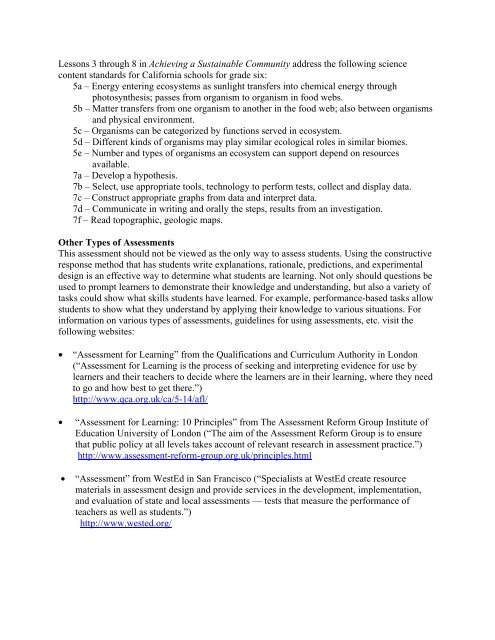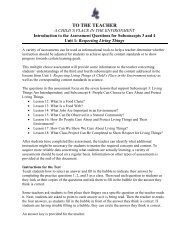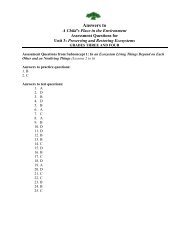Unit 6 Subconcept 1 - A Child's Place in the Environment (ACPE)
Unit 6 Subconcept 1 - A Child's Place in the Environment (ACPE)
Unit 6 Subconcept 1 - A Child's Place in the Environment (ACPE)
You also want an ePaper? Increase the reach of your titles
YUMPU automatically turns print PDFs into web optimized ePapers that Google loves.
Lessons 3 through 8 <strong>in</strong> Achiev<strong>in</strong>g a Susta<strong>in</strong>able Community address <strong>the</strong> follow<strong>in</strong>g science<br />
content standards for California schools for grade six:<br />
5a – Energy enter<strong>in</strong>g ecosystems as sunlight transfers <strong>in</strong>to chemical energy through<br />
photosyn<strong>the</strong>sis; passes from organism to organism <strong>in</strong> food webs.<br />
5b – Matter transfers from one organism to ano<strong>the</strong>r <strong>in</strong> <strong>the</strong> food web; also between organisms<br />
and physical environment.<br />
5c – Organisms can be categorized by functions served <strong>in</strong> ecosystem.<br />
5d – Different k<strong>in</strong>ds of organisms may play similar ecological roles <strong>in</strong> similar biomes.<br />
5e – Number and types of organisms an ecosystem can support depend on resources<br />
available.<br />
7a – Develop a hypo<strong>the</strong>sis.<br />
7b – Select, use appropriate tools, technology to perform tests, collect and display data.<br />
7c – Construct appropriate graphs from data and <strong>in</strong>terpret data.<br />
7d – Communicate <strong>in</strong> writ<strong>in</strong>g and orally <strong>the</strong> steps, results from an <strong>in</strong>vestigation.<br />
7f – Read topographic, geologic maps.<br />
O<strong>the</strong>r Types of Assessments<br />
This assessment should not be viewed as <strong>the</strong> only way to assess students. Us<strong>in</strong>g <strong>the</strong> constructive<br />
response method that has students write explanations, rationale, predictions, and experimental<br />
design is an effective way to determ<strong>in</strong>e what students are learn<strong>in</strong>g. Not only should questions be<br />
used to prompt learners to demonstrate <strong>the</strong>ir knowledge and understand<strong>in</strong>g, but also a variety of<br />
tasks could show what skills students have learned. For example, performance-based tasks allow<br />
students to show what <strong>the</strong>y understand by apply<strong>in</strong>g <strong>the</strong>ir knowledge to various situations. For<br />
<strong>in</strong>formation on various types of assessments, guidel<strong>in</strong>es for us<strong>in</strong>g assessments, etc. visit <strong>the</strong><br />
follow<strong>in</strong>g websites:<br />
• “Assessment for Learn<strong>in</strong>g” from <strong>the</strong> Qualifications and Curriculum Authority <strong>in</strong> London<br />
(“Assessment for Learn<strong>in</strong>g is <strong>the</strong> process of seek<strong>in</strong>g and <strong>in</strong>terpret<strong>in</strong>g evidence for use by<br />
learners and <strong>the</strong>ir teachers to decide where <strong>the</strong> learners are <strong>in</strong> <strong>the</strong>ir learn<strong>in</strong>g, where <strong>the</strong>y need<br />
to go and how best to get <strong>the</strong>re.”)<br />
http://www.qca.org.uk/ca/5-14/afl/<br />
• “Assessment for Learn<strong>in</strong>g: 10 Pr<strong>in</strong>ciples” from The Assessment Reform Group Institute of<br />
Education University of London (“The aim of <strong>the</strong> Assessment Reform Group is to ensure<br />
that public policy at all levels takes account of relevant research <strong>in</strong> assessment practice.”)<br />
http://www.assessment-reform-group.org.uk/pr<strong>in</strong>ciples.html<br />
• “Assessment” from WestEd <strong>in</strong> San Francisco (“Specialists at WestEd create resource<br />
materials <strong>in</strong> assessment design and provide services <strong>in</strong> <strong>the</strong> development, implementation,<br />
and evaluation of state and local assessments — tests that measure <strong>the</strong> performance of<br />
teachers as well as students.”)<br />
http://www.wested.org/




